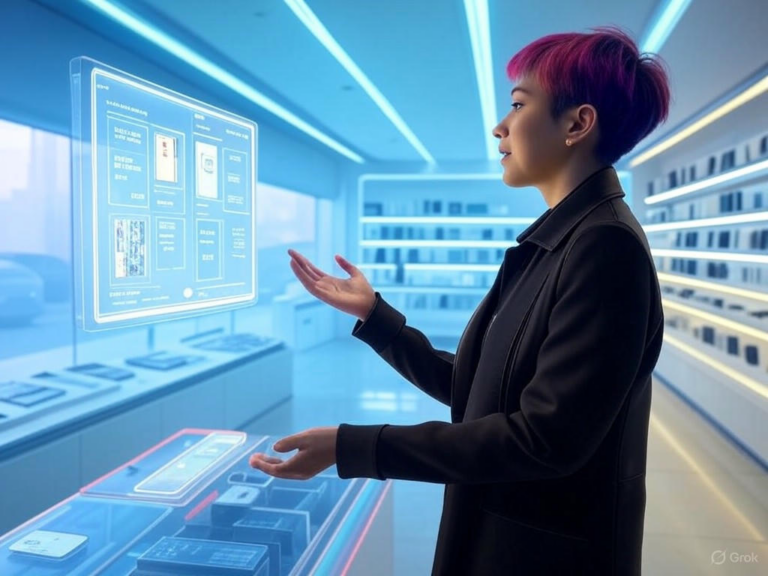
Microsoft Phi-4 AI Models Unveiled: Why They’re Revolutionary
A Fresh Look at Microsoft Phi-4 AI Models
Microsoft is pushing the boundaries of AI innovation with the launch of the Microsoft Phi-4 AI models. These compact yet powerful systems challenge the idea that only massive AI architectures can deliver top-tier results. Imagine deploying high-performance AI on everyday devices—what if your smartphone could handle complex problem-solving without relying on cloud servers?
This efficiency stems from Microsoft’s clever focus on quality over quantity, making Microsoft Phi-4 AI models a game-changer for developers and businesses alike. As we dive deeper, you’ll see how these models are opening up new possibilities in education, healthcare, and beyond.
Why Microsoft Phi-4 AI Models Are Redefining AI Standards
The Microsoft Phi-4 AI models stand out because they’re designed for real-world versatility, packing advanced reasoning and efficiency into smaller packages. This family includes specialized versions optimized for everything from quick decision-making to handling multiple data types like text, images, and audio. Ever wondered how AI could become more practical for daily use? These models make it possible by outperforming larger rivals while using far less resources.
Key to their success is a focus on high-quality training data and innovative techniques that boost performance without bloating the size. For instance, developers can now integrate Microsoft Phi-4 AI models into edge devices, speeding up processes in manufacturing or retail settings.
Unpacking the Strengths of Microsoft Phi-4 AI Models
- They excel in reasoning tasks, much like a human expert breaking down problems step by step.
- Support for multimodal inputs means they can process visual and auditory data alongside text, enhancing applications in dynamic environments.
- With features like long-context handling, these models keep track of extended conversations or documents effortlessly.
The Reasoning Edge of Microsoft Phi-4 AI Models
At the heart of the excitement are models like Phi-4-reasoning and Phi-4-reasoning-plus, which bring sophisticated logic to the table. Despite their modest size—around 14 billion parameters—these Microsoft Phi-4 AI models compete with giants that have hundreds of billions. They’re trained on curated datasets, drawing from sources like OpenAI’s o3-mini, to create reliable chains of thought for math, science, and coding challenges.
Have you ever faced a problem that needed precise, step-by-step analysis? Phi-4-reasoning makes that straightforward, offering accuracy that rivals much larger systems. This isn’t just theoretical—real tests show these models shining in competitive benchmarks.
Taking Microsoft Phi-4 AI Models to the Next Level
Phi-4-reasoning-plus builds on this with reinforcement learning, pushing performance even further. For example, it outperforms models with 671 billion parameters on exams like AIME 2025. This leap demonstrates how Microsoft Phi-4 AI models are flipping the script on AI development, prioritizing smart design over sheer scale. If you’re in research or tech, this could inspire your next project—try integrating it for tasks that demand deep insight.
Efficiency Wins with Microsoft Phi-4 AI Models
One common myth is that bigger AI models always mean better results, but Microsoft Phi-4 AI models prove otherwise. By leveraging synthetic datasets and chain-of-thought techniques, they deliver excellence in areas like math and planning without the hefty footprint. Picture a small business using these models for quick data analysis on limited hardware—it’s now a reality.
This approach not only cuts costs but also enhances accessibility. Here’s a quick overview of the lineup:
| Model | Parameters | Key Strength | Performance Highlight |
|---|---|---|---|
| Phi-4-mini | 3.8B | Speed and low-resource use | Beats larger models in everyday tasks |
| Phi-4-reasoning | 14B | Advanced logic | Matches OpenAI o3-mini and exceeds 70B models |
| Phi-4-reasoning-plus | 14B+ | Enhanced learning | Challenges top-tier models head-on |
| Phi-4-multimodal | 5.6B | Handling multiple data types | Ideal for integrated real-world apps |
Exploring Features of Microsoft Phi-4 AI Models
Running Smoothly on Edge Devices
One standout feature is how Microsoft Phi-4 AI models thrive on devices with limited power, like sensors in a factory. This opens up opportunities in healthcare, where real-time diagnostics can save time without needing constant internet. For teams working in remote areas, it’s a reliable tool that keeps operations flowing.
The Power of Multimodal Capabilities
Microsoft Phi-4 AI models like the multimodal variant process vision, audio, and text together, making them perfect for IoT applications. Think about a smart home system that understands spoken commands and visual cues—it’s no longer futuristic. This integration fosters innovation in fields like education, where interactive learning tools can adapt to different inputs.
Extending Reach with Function Calling
These models include function calling, allowing them to connect with external tools and APIs for fresh data. Developers might use this to build automated workflows, like fetching live weather updates in an app. It’s a simple yet effective way to make Microsoft Phi-4 AI models more adaptable and useful in dynamic settings.
Handling Long Contexts and Languages
With support for up to 128,000 tokens, Microsoft Phi-4 AI models manage lengthy discussions or documents with ease. Plus, their multilingual features break down language barriers, ideal for global businesses. If you’re creating content for diverse audiences, this could be the edge you need.
Real-World Wins with Microsoft Phi-4 AI Models
- Education: Use them for personalized tutoring that explains concepts step by step, even on tablets.
- Healthcare: Detect anomalies in patient data quickly, improving outcomes in clinics.
- Manufacturing: Monitor equipment in real time to prevent downtime.
- Retail: Offer multilingual customer support that feels intuitive and responsive.
- Software Development: Assist with code debugging and planning, speeding up your workflow.
These applications show how Microsoft Phi-4 AI models can transform industries. For instance, a teacher might ask, “How can I make lessons more interactive?”—and find answers in these tools.
Proven Results from Microsoft Phi-4 AI Models
Benchmarks reveal the true power of Microsoft Phi-4 AI models, with Phi-4-reasoning showing over 50% better accuracy in math tests like OmniMath. They also edge out competitors in coding tasks, proving that size isn’t everything. A study from Microsoft’s research highlights how these advancements are reshaping AI expectations.
This data isn’t just numbers—it’s proof that smart training methods can deliver big results. If you’re evaluating AI options, consider how Microsoft Phi-4 AI models stack up against the competition.
Open Access and Ethical Focus
Microsoft has made these models available on platforms like Hugging Face, encouraging widespread use and innovation. This openness ensures that Microsoft Phi-4 AI models support ethical principles like fairness and privacy. As AI evolves, adhering to these standards will be key to building trust.
Looking ahead, future updates could bring even more capabilities, tailored for emerging needs. What excites you most about this direction?
Wrapping Up: The Impact of Microsoft Phi-4 AI Models
In summary, Microsoft Phi-4 AI models are setting a new benchmark for efficient, intelligent AI. Their ability to handle complex tasks on everyday devices makes them a vital tool for modern challenges. Whether you’re a developer experimenting with new ideas or a business leader seeking solutions, these models offer a pathway to innovation.
Ready to explore more? Dive into the resources below or share your experiences in the comments—let’s discuss how Microsoft Phi-4 AI models could work for you.
References
- Microsoft. “One Year of Phi: Small Language Models Making Big Leaps in AI.” Azure Blog. Link.
- Feiner, L. “Microsoft’s Most Capable New Phi-4 AI Model Rivals the Performance of Far Larger Systems.” TechCrunch. Link.
- Microsoft Research. “Phi-4 Reasoning.” PDF Link.
- Microsoft. “Empowering Innovation: The Next Generation of the Phi Family.” Azure Blog. Link.
- Microsoft Tech Community. “Welcome to the New Phi-4 Models.” Link.
Microsoft Phi-4 AI models, small language models, reasoning AI, multimodal AI, AI efficiency, Microsoft AI innovation, advanced reasoning capabilities, real-world AI applications, edge device AI, AI performance benchmarks







